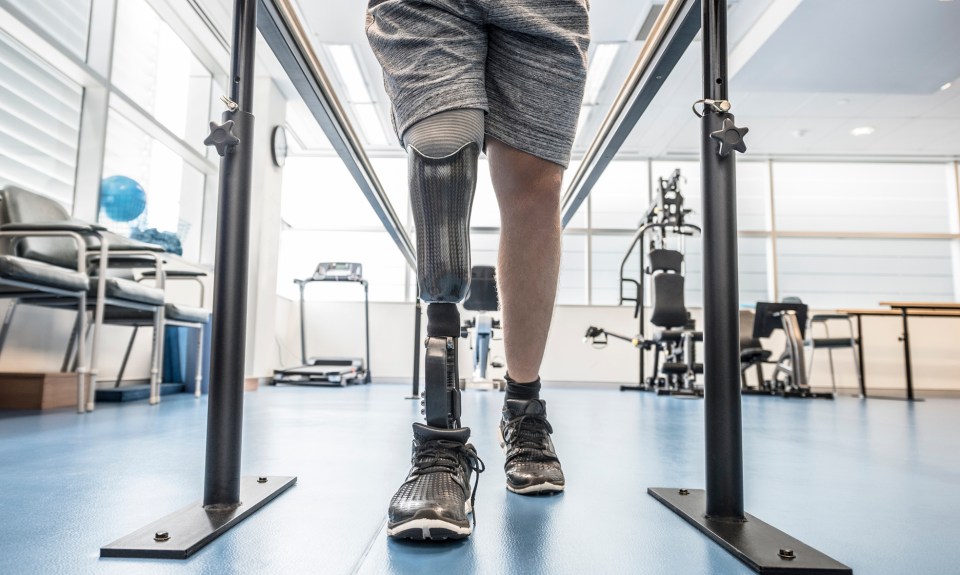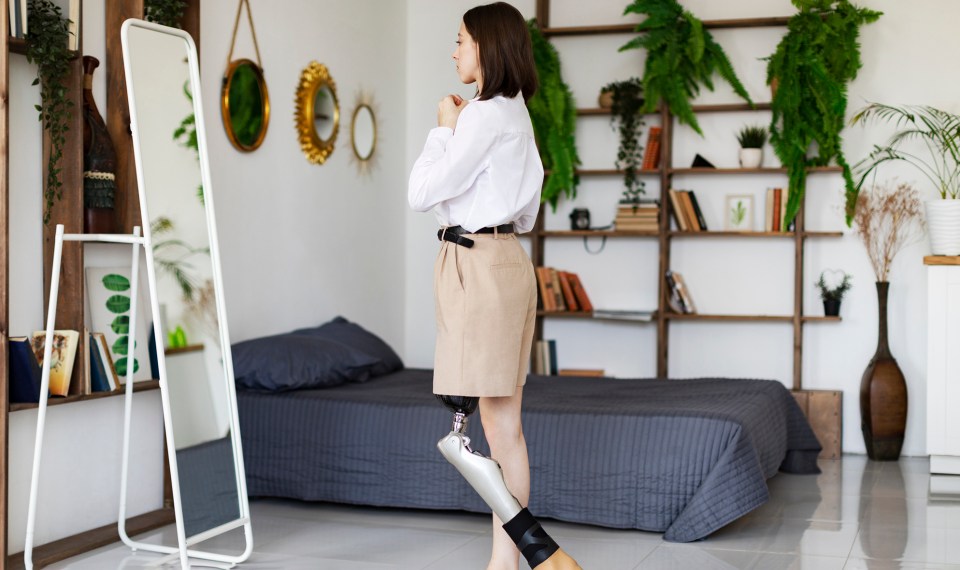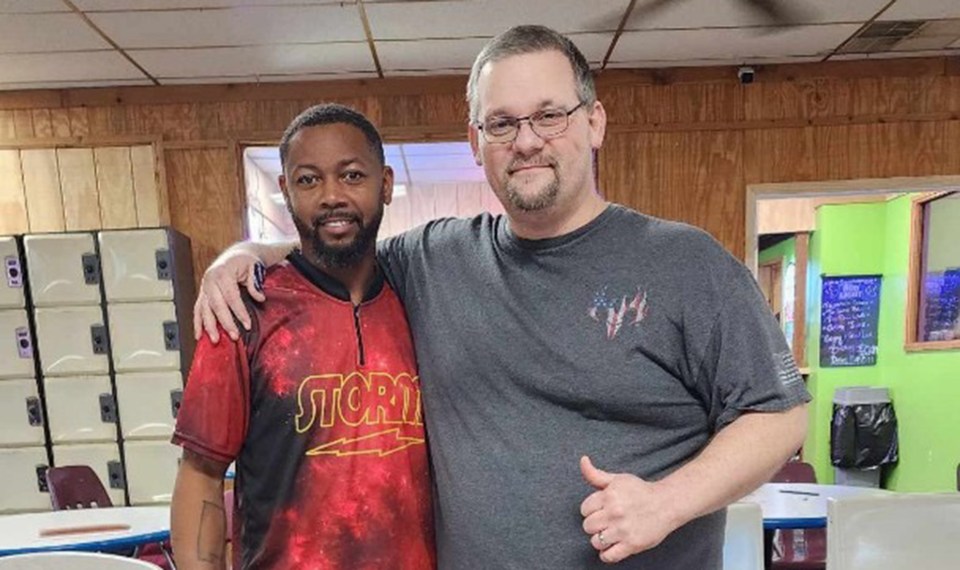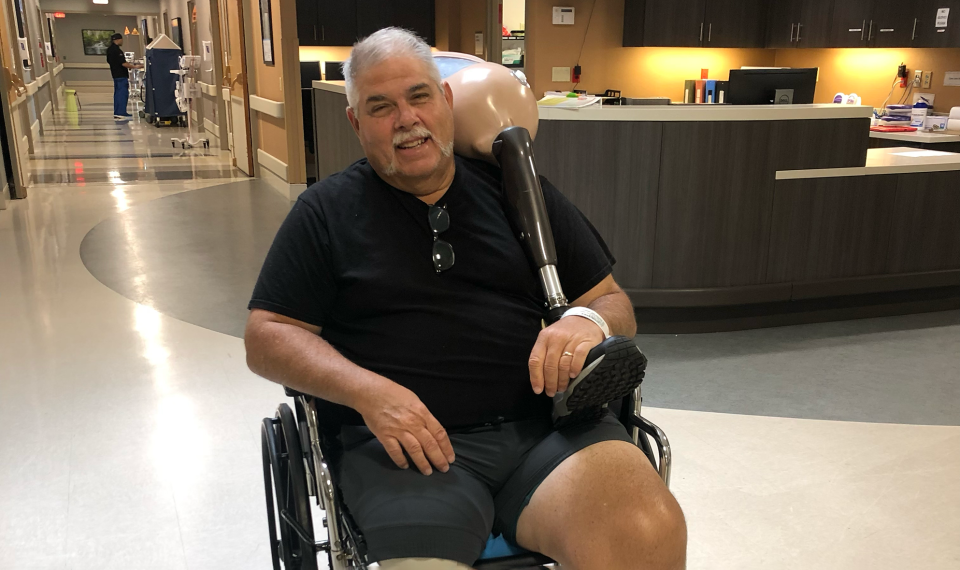Limb loss or amputation is a life-changing event that can significantly impact an individual’s physical and mental wellbeing. In the United States, approximately 2 million individuals have some level of limb amputation, with most major amputations performed in the lower extremity (LE), either below the knee (transtibial) or above knee (transfemoral). Only 3% involve the upper extremity (UE).
Causes and Risk Factors of Amputation
Vascular disease and trauma represent the vast majority of individuals with amputation, accounting for 54 and 45% of amputations, respectively. Vascular disease (poor circulation) happens gradually and it is progressive. The person is sometimes not aware that the blood vessels are narrowed until it has caused serious effects from restriction of the blood flow and supply to the particular area affected.
Diabetes and Foot Ulcers
The risk of amputation is higher where peripheral vascular disease and diabetes coexist. People with diabetes mellitus have a 10 times higher risk of amputation.
Smoking
Smoking is another risk factor for lower limb amputation due to nicotine’s effect of reducing blood flow, which impairs the healing process.
Infections
Previously healthy individuals, when affected by systemic infections such as bacterial infections, are at risk of amputation of limbs either as a treatment of choice for the infection or as a life-saving measure.
Congenital deformities
Amputation secondary to cancer or congenital deformities occurs much less frequently. Only a combined 2.5% of the total population of individuals with limb loss attribute it to one of these two causes.
Caring for Your Residual Limb
Positioning and Stretching
Proper positioning of the residual limb is of primary importance to prevent development of contracture, when the joint becomes stiff from lack of movement. Do stretching exercises daily to make sure that you can straighten your knee and hip, both of which are necessary for efficient walking.
Manage Swelling
Decrease the amount of swelling on the limb by proper serial wrapping with an elastic bandage. In the early stage, do not take a bath or shower in the morning. Hot water causes your limb to swell making it difficult to put on your prosthesis.
Proper Skin Care
Proper skin care is key to proper healing of your residual limb. This includes:
- Check your skin twice a day for any sign of skin breakdown or infection. If you can’t see the end of your residual limb, use a long-handled mirror.
- Any red pressure marks that last a few minutes after removal of prosthesis may be a sign that the socket needs to be checked by your prosthetist.
- If the skin on your limb opens, do not wear your prosthesis and make an appointment to see your doctor or prosthetist.
- If you have reduced or no sensation in your residual limb, check your limb more frequently and avoid exposure to heat.
- Use a shrinker sock at night.
- Add socks as necessary for a comfortable fit of prosthesis.
Below-Knee Amputation
If you have a below-knee amputation, don’t rest your knee on a pillow as this can cause tightness and contracture of the soft tissues at the back of your leg. Also, don’t leave your residual limb hanging down while seated on a chair or bed to prevent swelling.
Above-Knee Amputation
Straightening the hip is an important part of caring for an above the knee amputation. Lay on your stomach at least 30 minutes daily to straighten the hip. Do not place a pillow in between your thighs as this can cause an abnormally wide-based walking pattern, and do not rest your limb on a pillow when laying in bed or on the handle bar of crutches when standing.
How Inpatient Rehabilitation Can Help
Rehabilitation is generally provided in both pre-prosthetic and prosthetic training phases following an amputation. The pre-prosthetic rehabilitation seeks to address limb wound healing, limb strength and range of motion, and basic mobility without the use of a prosthetic device. In the prosthetic training phase, the aim is to achieve the most efficient gait possible on different terrains using the prosthesis.
A 2008 study on the effectiveness of inpatient rehabilitation after below-knee or above-knee amputation found that the “receipt of rehabilitation in the acute postoperative inpatient period was associated with a greater likelihood of 1-year survival and home discharge from the hospital. Results support early postoperative inpatient rehabilitation following amputation.”
Interdisciplinary Care Team
During inpatient rehabilitation, patients receive an interdisciplinary care plan with goals that are tailored individually for their needs. A rehabilitation physician who leads the interdisciplinary care team sees patients daily. A psychiatrist or psychologist may assist patients in dealing with limb loss, and nursing and nutrition services play an important role in accelerating wound healing. Case managers work with patients and caregivers to offer in-depth discharge planning services and the best solution for each patient’s transition to the next level of care.
Personalized Therapy
Patients participate in an intensive rehabilitation program (both pre-prosthetic and prosthetic training) with occupational and physical therapy for at least three hours a day, five days per week. Patients are trained by OTs on how to independently perform essential and routine tasks including personal hygiene, toileting, upper/lower body dressing, and using adaptive equipment as necessary. Physical therapists help patients regain strength and normal posture, movement and function following surgery. They train patients on how to transfer safely (from bed to wheelchair, toilet transfers and car transfers), how to move about in a wheelchair, and how to stand and walk with an assistive device.
Therapists also provide patients with non-pharmacologic interventions for pain such as desensitization and phantom pain management. Education on how to care for their residual limb in preparation for fitting and using their prosthetic leg, fall prevention, and techniques on how to get up in case of a fall are all part of an amputee rehab program in an inpatient rehabilitation hospital.
Adapting to a Prosthesis
The timeframe for getting a prosthesis is unique to each individual’s condition and healing after surgery. Prosthetic fitting begins once the surgical incision has completely healed, residual limb swelling has significantly decreased and the individual’s strength has improved.
It takes time, practice and proper training to become accustomed to a prosthesis. It is necessary to contact your prosthetist when the comfort and fit does not feel right, and strategies learned during therapy for safe and efficient movement in performing functional tasks should be continued at home.
Patients may also consider joining support groups and meeting with peer visitors who act as role models. The Amputee Coalition’s information center, web site, educational resources, peer and support group network, and many other programs can help a new amputee move towards recovery.
MaryGrace Artillaga is a physical therapist at Encompass Health Rehabilitation Hospital of Cypress. Mary is a Board-Certified Neurologic Clinical Specialist and has achieved her Certificate of Competency in Vestibular Therapy.
References
- Stineman MG, Kwong PL, Kurichi JE, Prvu-Bettger JA, Vogel WB, Maislin G, Bates BE, Reker DM. The effectiveness of inpatient rehabilitation in the acute postoperative phase of care after transtibial or transfemoral amputation: study of an integrated health care delivery system. Arch Phys Med Rehabil 2008;89:1863-72.
- Benjamin J. Darter, PT, PhD, Carolyn E. Hawley, PhD, CRC, Amy J. Armstrong, PhD, CRC, Lauren Avellone, PhD, and Paul Wehman, PhD. Factors Influencing Functional Outcomes and Return-to-Work After Amputation: A review of the literature. J Occup Rehabil. 2018 Dec; 28(4): 656–665.
- Dillingham TR, Pezzin LE, MacKenzie EJ. Limb amputation and limb deficiency: epidemiology and recent trends in the United States. South Med J. 2002;95(8):875–83.
- Pasquina PF, Miller M, Carvalho AJ, Corcoran M, Vandersea J, Johnson E, Chen YT. Special considerations for multiple limb amputation. Current physical medicine and rehabilitation reports. 2014 Dec 1;2(4):273-89. Available from: https://www.ncbi.nlm.nih.gov/pmc/articles/PMC4228106/ (Accessed 25 April 2021)
- Carmona GA, Hoffmeyer P, Herrmann FR, Vaucher J, Tschopp O, Lacraz A, Vischer UM. 2005, Major lower limb amputations in the elderly observed over ten years: the role of diabetes and peripheral arterial disease. Diabetes Metab. 2005 Nov;31(5):449-54.
- https://www.physio-pedia.com/Pathology_Leading_to_Amputation#cite_note-Hampton-11
- Barbara Engstrom and Catherine Van de Ven, 1999, Therapy for Amputees, 3rd Edition, Churchill Livingston ISBN: 978-0-443-05975-9
- Varma P, Stineman MG, Dillingham TR. Epidemiology of limb loss. Phys Med Rehabil Clin N Am. 2014;25(1):1–8. doi: 10.1016/j.pmr.2013.09.001. [PMC free article] [PubMed] [CrossRef] [Google Scholar]
- Paddy Rossbach, RN, Terrence P. Sheehan, MD. (May/June 2008).Tips for Taking Care of Your Limb. https://www.amputee-coalition.org/resources/tips-for-taking-care/
- Esquenazi A, DiGiacomo R. Rehabilitation after amputation. J Am Podiatr Med Assoc. 2001;91(1):13–22. [PubMed] [Google Scholar]
- Encompass Health Corporation. (2020). Case Management. https://www.encompasshealth.com/careers/our-roles-and-disciplines/irf-case-management
- Amputee Coalition. (2021). Points to Know and Consider When Preparing for and Undergoing an Amputation. https://www.amputee-coalition.org/resources/points-to-know/
The content of this site is for informational purposes only and should not be taken as professional medical advice. Always seek the advice of your physician or other qualified healthcare provider with any questions you may have regarding any medical conditions or treatments.



